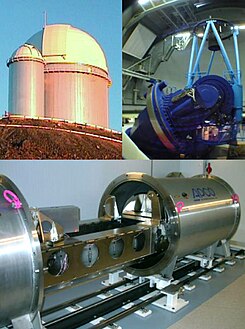High Accuracy Radial Velocity Planet Searcher
HARPS ( High Accuracy Radial Velocity Planet Searcher ) is an Échelle spectrograph for the ESO 3.6 meter telescope at the La Silla Observatory in Chile. It is used for high-precision measurement of the radial velocity of stars and thus for the discovery of exoplanets . With an accuracy of approx. 1 m / s, HARPS is one of the most accurate instruments for this purpose. HARPS was developed by a consortium led by the Observatoire de Genève and installed on La Silla in 2002; The first measurements were made in 2003. The sister instrument HARPS-N for the northern sky went into operation in 2012 at the Telescopio Nazionale Galileo .
Discoveries
Until the start of the Kepler mission, HARPS was one of the most successful instruments in the search for exoplanets with over 60 discovered exoplanets until 2009. New planets were also found with the help of the instrument in 2018 and the number of exoplanets found has now risen to around 150 increased. The spectrograph is still one of the most successful instruments in the search for exoplanets using the radial velocity method .
Many of the spectacular exoplanets mentioned in the press, such as Gliese 667 Cc , Ross 128 b or the Gliese 581 planets, were discovered with the HARPS spectrograph. Even with the star HD 10180 , which has long been known as the system with the most exoplanets , most of the companions were discovered with the help of HARPS. With the sister instrument HARPS-N, over 10 exoplanets were discovered in the northern hemisphere.
Controversy
Some HARPS detection reports were later questioned due to the quality of the data or because interference possibly caused by the central stars was insufficiently taken into account. These include the unconfirmed Alpha Centauri Bb , Gliese 581 d and also some planets of the Gliese 667 C system. Many of them are now (2020) controversial or even disproved.
Selection of exoplanets discovered using data from HARPS
| planet | Date of announcement | comment |
|---|---|---|
| HD 330075 b | February 10, 2004 | |
| My Arae c | August 25, 2004 | |
| HD 2638 b | March 22, 2005 | |
| HD 27894 b | March 22, 2005 | |
| HD 63454 b | March 22, 2005 | |
| HD 93083 b | March 30, 2005 | |
| HD 101930 b | March 30, 2005 | |
| Gliese 581 b | September 8, 2005 | |
| HD 4308 b | October 12, 2005 | |
| HD 212301 b | January 25, 2006 | |
| HD 69830 b | May 18, 2006 | |
| HD 69830 c | May 18, 2006 | |
| HD 69830 d | May 18, 2006 | |
| My Arae d | 14./18. August 2006 | |
| Gliese 674 b | April 2, 2007 | |
| HD 100777 b | April 6, 2007 | |
| HD 190647 b | April 6, 2007 | |
| HD 221287 b | April 6, 2007 | |
| Gliese 581 c | April 23, 2007 | |
| HD 171028 b | August 7, 2007 | |
| HD 40307 b | June 27, 2008 | |
| HD 40307 c | June 27, 2008 | |
| HD 40307 d | June 27, 2008 | |
| Gliese 176 b | September 4, 2008 | |
| Gliese 581 e | April 21, 2009 | |
| HD 10180 c to h | November 23, 2010 | |
| Gliese 667 cc | November 21, 2011 | is probably in the HZ |
| Gliese 163 b | September 6, 2012 | |
| Gliese 163 c | September 6, 2012 | is probably in the HZ |
| Gliese 667 Ce | 2013 | |
| Gliese 667 Cf | 2013 | |
| Gliese 667 Cg | 2013 | |
| Wolf 1061 b | 2015 | |
| Wolf 1061 c | 2015 | is probably in the HZ |
| Wolf 1061 d | 2015 | |
| Ross 128 b | 2017 | is probably in the HZ |
Web links
- HARPS website of the Observatoire de Genève
- HARPS website of ESO
- Announcement about the publication of the discovery of 30 new exoplanets by HARPS on NZZ online

